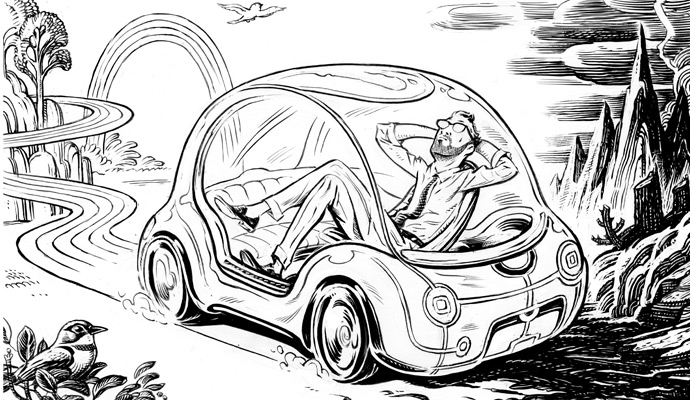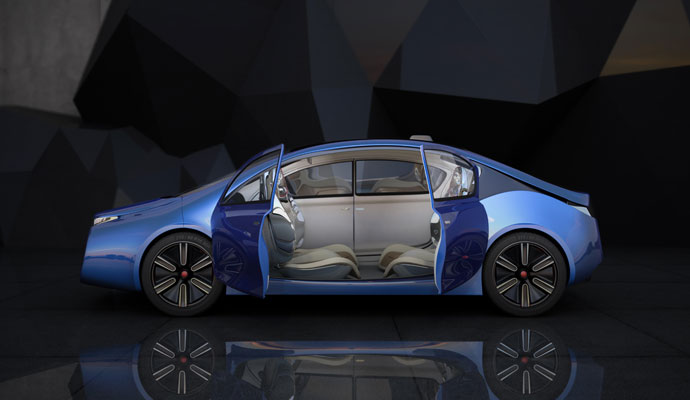The Right Track for Connected Cars
Five ways automakers can design for safety and profitability.
It’s the Daytona 500 of vehicle manufacturing: the race to bring connected cars, light trucks, and SUVs to market. Unprecedented safety, driver assistance, and infotainment features promise to revolutionize the driving experience. Still, few industry executives are confident that their current connected vehicle initiatives are on the right track.
Their uncertainty is understandable. For automakers, getting “connected” requires joining forces with the high-tech consumer electronics industry — an unlikely partnership, for several reasons. Vehicle manufacturers have intricate organizational structures and supply chains that have evolved over decades. They have long design and development horizons, and stringent regulatory and safety mandates. High-tech companies have simpler structures and supply chains that can shift more swiftly with consumer demand. They have much shorter development cycles and an “act now, apologize later” mind-set that isn’t appropriate for products whose failure can result in the loss of life. And then there’s Moore’s Law: The continual compounding of computing power implies that automakers will be called on to navigate a mind-boggling explosion of connectivity features and functions.
Auto companies have never before been confronted with an opportunity and challenge of this magnitude. The following five imperatives can help soften the speed bumps.
1. Treat connectivity as an integral element of the automotive value proposition. Auto manufacturers naturally covet the high returns and fast growth of the digital sector — if for no other reason than to offset the substantial investments required to bring vehicles to market. They are also eyeing the money that could be made selling endless terabytes of customer data generated from connected vehicle technology. But they cannot afford to set up connectivity initiatives as separate business units with the sole purpose of generating incremental revenue (which implies a lack of strategic focus) and selling customer data (which carries brand-threatening privacy risks). Like the car phone fad of the 1980s and early 1990s, these enticing prospects are a dangerous distraction from the automakers’ real game, which remains selling cars.
That said, automakers should be integrating rich connectivity features as a way of differentiating themselves as much as possible from their competitors. Such features, which we estimate currently cost only about US$500 per vehicle to manufacture, already represent an outsized portion of vehicle value in consumers’ minds: In a 2014 Autotrader.com survey of car shoppers, 56 percent of vehicle owners said they would switch to a different vehicle brand to get the digital features they want.
To protect and build their brands, automakers should focus on determining which kinds of digitally connected functionality to integrate into their vehicles and how to achieve that integration. They shouldn’t try to fully control the design process for infotainment features. Consumer device makers and app developers have the scale, product development speed, technical know-how, and innovation ecosystems in place to quickly develop the features. But vehicle manufacturers must always have the final word on what goes into their vehicles. They should govern and curate how a driver interacts with the machine, and they should design and own driver-assist and safety features.
2. Follow the dictates of safety in driving every aspect of the connected vehicle. Safety is king. Although consumers might relish the idea of using more entertainment apps in their cars, and some high-tech companies might want to simply plug their infotainment systems into vehicles, vehicle manufacturers cannot compromise on safety. Stretching prudence to gain a marketing advantage would put their customers’ lives at risk, a mistake from which it would be hard to recover.
Even drivers who are clamoring for new technology consider their own safety to be paramount. Autotrader’s survey found that 84 percent of vehicle owners value safety features over infotainment features. And lawmakers already have their eye on regulating these new features to cut down on driver distractions: In February 2014, Senator Jay Rockefeller, chairman of the U.S. Senate Committee on Commerce, Science, and Transportation, warned carmakers and technology companies that they needed to make it a priority to reduce driver distractions linked to new Internet-connected features. Vehicle makers should therefore prioritize safety in their infotainment investment, by creating features that are fun to use without taking the driver’s attention off the road.
3. Build the capabilities to ensure security. Aside from safety concerns, automakers must be prepared to defend connected vehicles against cyberattacks. Tesla has built wireless connection into its sticker price, and BMW is not far behind. Soon, as costs decline and functionality expands, most vehicles will include wireless connections, the ability to diagnose their own mechanical problems, and smart device connections, all of which will generate and house enormous amounts of data. Some of these vehicles will be expensive and flashy, attracting thrill-seeking hackers. And they’re a vulnerable target for hackers with the malicious intent to damage property and inflict harm.
Unfortunately, vehicle manufacturers are lagging behind in this regard. They have to work harder to develop cybersecurity measures and technology to address a level of risk higher than that facing most high-tech companies. They will need to build backups for critical systems, as well as multiple firewalls that separate a car’s subsystems from one another. That way, if one fails or is hacked, the others will stay functional and protected. And still, this will not be enough.
The way vehicles are currently designed and engineered will also have to evolve. Cybersecurity can’t work with a design-it-once approach; it demands constant monitoring for new threats and the continuous adaptation and updating of protection systems. Further, when threats emerge, automakers won’t have the luxury of time. They must proactively build highly evolved cybersecurity skills and capabilities.
4. Revamp the traditional product development cycle. The typical automotive product development cycle is currently three to five years, with a mid-cycle facelift that changes features such as electronics or exterior design elements. Connected vehicles will fundamentally disrupt that pattern. Automakers have to work swiftly to keep up with the lightning-fast development and updating of the devices and apps that will populate their vehicles. Imagine how quickly a vehicle manufacturer could fall behind if it offered new electronic architectures and functionality only two or three times a decade. And imagine the dissatisfaction of customers, who have grown accustomed to instant gratification when it comes to new technology, finding themselves stuck with generations-old features until they buy a new vehicle.
Connected vehicles will fundamentally disrupt the automotive product development cycle.
A few automakers are beginning to update software-oriented features more often. But they will all need to rethink and reconcile these conflicting development cycles. They’ll have to build a more modular electronics system — rather than one that’s vehicle-specific — and virtual updates will be needed to deliver electronics and software content more quickly, along with updated cybersecurity.
This will require a more segmented and nuanced approach to telematics offerings. Multiple generations of electronics architecture and content for driver-assist and safety features will have to be designed using parallel and overlapping design cycles, so that interim updates are possible. Automakers will also need to invest in extra vehicle networking and memory capacity in anticipation of interim upgrades, and provide the means of delivering updates to their dealer networks and customers. Even shorter cycles will be required for infotainment features, especially as consumers’ smart devices become more powerful and ubiquitous. Already, consumers are insisting on more seamless integration of these devices — according to a 2015 J.D. Power study, they’re dissatisfied with the quality of offerings currently on the market. To catch up, automakers will need to continually monitor market trends and react quickly, as well as tap into the vast ecosystem of app developers.
5. Adapt the vehicle manufacturing operating model to accommodate connected vehicles. The nature and needs of automotive manufacturing have produced a complex and highly specialized operating model in which functional silos coordinate with one another in unique ways. Although highly successful for many years, this model cannot withstand the addition of the myriad requirements that come with connected vehicles.
Developing and producing this technology will require firms to layer a broad set of considerations and constraints into design deliberations. These vehicles will simultaneously engage multiple internal functional organizations, product development programs, and vehicle platforms. And they will require that the automakers’ supplier ecosystem expand to include new and unfamiliar players, such as technology and app developers, who come from a very different operating environment.
These challenges are incredibly difficult to manage. In order to address them, most vehicle manufacturers are structuring their initiatives in one of two ways: by establishing one or more new silos or by appointing a connected car czar charged with coordinating the initiative across existing silos. Neither strategy will be good enough.
Instead, these firms will need to take an evolutionary approach to integrating connected vehicle activities into their existing structures. They should start by prioritizing connectivity initiatives, building a truly cross-functional connected vehicle team, making clear who has governance and decision-making rights, and identifying and establishing the new capabilities that such vehicles will require. Eventually, connected vehicle activities must be as established and structurally integrated as other groups — such as those that design powertrains — are today.
The possibilities afforded to vehicle manufacturers by the accelerating rate of technological progress are thrilling. Indeed, they are limited only by human imagination, regulatory requirements, and customer demand. But as with any other opportunity of such magnitude, the unknowns can be nerve-racking for anyone whose future rides on getting it right. These five imperatives will ensure a smooth start. ![]()
Reprint No. 00329
Author profiles:
- Evan Hirsh is a partner with Strategy& based in Chicago. He leads the firm’s North American automotive practice.
- Marian H. Mueller is a partner with Strategy&’s automotive practice, and is based in Florham Park, N.J.
- Kumar Krishnamurthy is a partner with Strategy&’s digital business technology practice, and is based in Chicago.
-
Also contributing to this article were Strategy& senior associates Arjun Gupta and Akshay Singh.






